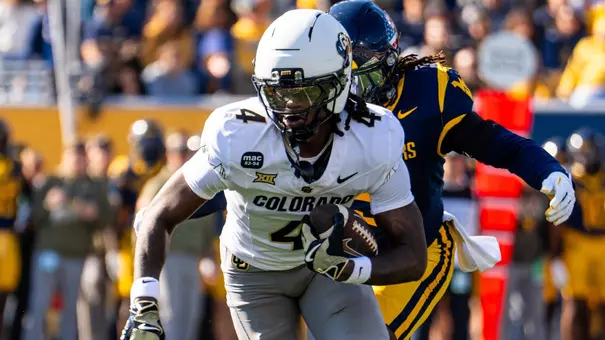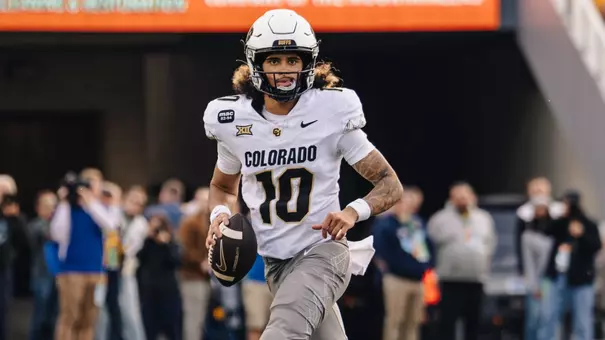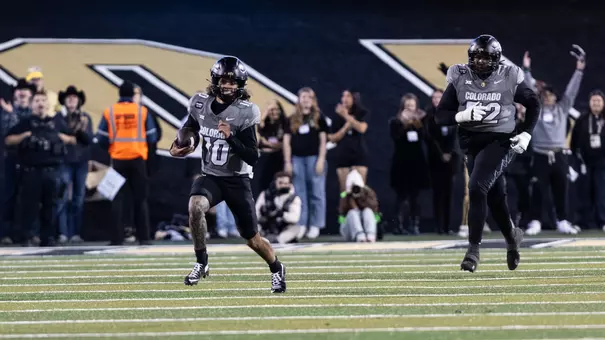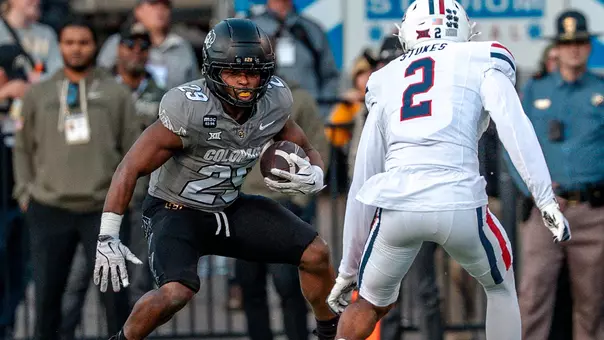Colorado University Athletics
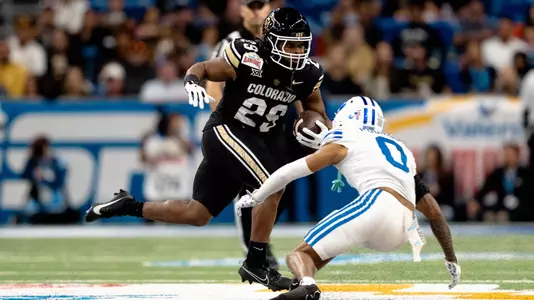
Micah Welch runs against BYU in the 2024 Alamo Bowl
Photo by: Tyler Davis
CU & BYU: A Most Interesting History
September 26, 2025 | Football
Colorado and Brigham Young have met just 13 times on the football field, despite the fact that Boulder and Provo are only 496 miles apart (338 direct as the crow flies). This is the third time both are members of the same conference – BYU joined the Rocky Mountain Athletic Conference in 1922, where CU had been a member since 1909; both were then charter members of the Mountain States Conference (1939-47) and were joined again when CU returned to the Big 12 last year.
There were as many as 12 teams in the RMAC back in the day, thus opponents weren't on all schedules annually; in fact, CU and BYU met only four times as members of the league (1923, 1934, 1937 and 1938). They played six times in the nine years both were in the Mountain States, otherwise have faced off once in the regular season and twice in bowl games. Tonight is their first Big 12 conference game against each other, though both were paired last December in the Alamo Bowl, where the Cougars prevailed, 36-14.
There are some interesting similarities between the universities. BYU was founded in 1875, some 21 years before Utah became the nation's 45th state. The Utah territory was founded in 1850, so statehood took a while. CU was also founded before Colorado became the 38th state – but just five months prior in March of 1876. (The first building on campus still remains – Old Main – as construction on it started in September 1875).
(Trivia: which states were admitted to the union between Colorado and Utah? Answers at the end of the article.)
Provo was founded as a permanent settlement by Mormon pioneers in 1849, and was incorporated the following year, coinciding with the Utah territory. It was named after Etienne Provost, a French-Canadian fur trapper who was a frequent visitor to the area.
Prior to March 1861, Colorado as we know it today was made up of four different Federal territories – Kansas and Utah, both owning about the same number of square miles separated by the Continental Divide – with small portions of the state located in both Nebraska's and New Mexico's acreage.
Boulder, on the other hand, was in western Kansas territory when it was founded in 1859 – the city wasn't incorporated until 1871 (on November 4). Nothing extraordinary about how its name came about, simply for the abundance of boulders and large rocks found in the streams in town as well as those in the nearby foothills. Boulder "won" the location for the state's flagship university, when the state government awarded the prison to Canon City, which was in competition with Boulder for the two locations.
History lesson over; now on to the gridiron.
Colorado leads the all-time series, 8-4-1, winning the first game between the two on October 20, 1923. Fullback Earl Loser scored four touchdowns to lead the Silver & Gold to a 41-0 shellacking of the Cougars in Boulder (BYU had formally adopted the nickname on the first of the month).
The next time they played was on the same date in 1934, three weeks before CU's athletic teams officially became known as the Buffaloes. That game was in Provo, with CU winning big again, 48-6. Kayo Lam scored three touchdowns – including one on a 90-yard run – and intercepted a pass to pace the Buffaloes on that Saturday afternoon; CU broke open a close game with 34 points in the fourth quarter, which remains the most a CU team has ever scored in a fourth quarter, and the second-most in any quarter on the road. (And as was the case back then, CU would hop on a train and return to Boulder).
CU would go on to win eight of the first 10 games in the series (with one tie), but its last win against the Cougars came some 78 years ago, on October 18, 1947 in Boulder. Let's revisit that contest, where the Buffaloes escaped with a 9-7 victory.
Now there was Willis Reed, with a torn thigh muscle, limping in game seven for New York in game seven of the 1970 NBA finals, helping to keep Los Angeles' Wilt Chamberlain at bay and help the Knicks to the championship. And there was Kirk Gibson, who despite hamstring and knee injuries, hitting a dramatic pinch-hit, walk-off home run against Oakland in game one of the '88 World Series to send the Los Angeles Dodgers on their way to the title.
The injuries to Reed and Gibson were well-documented on the national scene, but locally, before those two there was Colorado end and placekicker, John Zisch. It was CU's final season in the Mountain States Conference, and league rivals wanted to usher the Buffaloes out of the league hoping they'd regret the move to the Big Seven. Colorado won the opener at Iowa State (7-0), but then fell at Army (47-0) and at home to Missouri (21-0) with the 2-2 Cougars heading to town.
Zisch had suffered a broken bone in his left leg late in the opener against the Cyclones – where he caught three passes for 51 yards and made CU's extra point – and wasn't supposed to even dress for the game, much less play. But there he was in the lineup at kickoff.
The Buffs had taken the lead with two seconds left in the first quarter, when Dick Schrepferman sprinted 26 yards around the left end and down the sideline for a touchdown. But the score remained 6-0 as Zisch missed the extra point, his only sour play of the game. But the law student from Johnstown would more than make up for it as the battle progressed.
The first of three big plays by the burly 6-foot-3 end came on the second half kickoff; the last man in position to make a play, he tackled BYU's Scotty Deeds at the CU 23 after a 72-yard return. The Cougars failed to score, fumbling the ball over to CU three plays later. But BYU would go ahead, 7-6, just under six minutes into the fourth quarter, setting the stage for a series of Zisch heroics.
CU failed to score on its next two possessions, but with 40 seconds remaining, Paul Briggs forced a fumble that Zisch recovered on the BYU 4-yard line, giving an unexpected life for the Buffaloes. The Cougars held the Buffs out of the end zone, the ball literally inches from the goal line with four ticks left. From a tricky angle, Zisch then split the uprights with an 8-yard field goal as time expired – the first such game winning field goal in school history, to rally the Buffaloes to victory.
The series didn't resume until 1981, albeit briefly, a one-game visit to Folsom Field by the Cougars. They left town with their only win to date in Boulder, a 41-20 verdict, BYU's fourth straight victory to open what would become an 11-2 season and No. 11 final ranking. The Buffaloes finished the year 3-8 (winning the opener, homecoming and the season finale), and welcomed Bill McCartney as their new head coach the following summer.
The only two meetings in the last 42 years came in the postseason. In the 1988 Freedom Bowl, despite Eric Bieniemy rushing for 144 yards and two touchdowns, two field goals in the final 4:11 rallied the Cougars to a 20-17 win. Another 36 years passed and then the aforementioned pairing last December's Alamo Bowl (BYU the Big 12's selection, CU under the standing agreement as the Pac-12 representative), still one of the rare times two teams from the same conference squared off in a bowl game.
(Trivia answers: 39. North Dakota, 1889; 40. South Dakota, 1889; 41 Montana, 1889; 42. Washington, 1889; 43. Idaho, 1890; 44. Wyoming, 1890).
There were as many as 12 teams in the RMAC back in the day, thus opponents weren't on all schedules annually; in fact, CU and BYU met only four times as members of the league (1923, 1934, 1937 and 1938). They played six times in the nine years both were in the Mountain States, otherwise have faced off once in the regular season and twice in bowl games. Tonight is their first Big 12 conference game against each other, though both were paired last December in the Alamo Bowl, where the Cougars prevailed, 36-14.
There are some interesting similarities between the universities. BYU was founded in 1875, some 21 years before Utah became the nation's 45th state. The Utah territory was founded in 1850, so statehood took a while. CU was also founded before Colorado became the 38th state – but just five months prior in March of 1876. (The first building on campus still remains – Old Main – as construction on it started in September 1875).
(Trivia: which states were admitted to the union between Colorado and Utah? Answers at the end of the article.)
Provo was founded as a permanent settlement by Mormon pioneers in 1849, and was incorporated the following year, coinciding with the Utah territory. It was named after Etienne Provost, a French-Canadian fur trapper who was a frequent visitor to the area.
Prior to March 1861, Colorado as we know it today was made up of four different Federal territories – Kansas and Utah, both owning about the same number of square miles separated by the Continental Divide – with small portions of the state located in both Nebraska's and New Mexico's acreage.
Boulder, on the other hand, was in western Kansas territory when it was founded in 1859 – the city wasn't incorporated until 1871 (on November 4). Nothing extraordinary about how its name came about, simply for the abundance of boulders and large rocks found in the streams in town as well as those in the nearby foothills. Boulder "won" the location for the state's flagship university, when the state government awarded the prison to Canon City, which was in competition with Boulder for the two locations.
History lesson over; now on to the gridiron.
Colorado leads the all-time series, 8-4-1, winning the first game between the two on October 20, 1923. Fullback Earl Loser scored four touchdowns to lead the Silver & Gold to a 41-0 shellacking of the Cougars in Boulder (BYU had formally adopted the nickname on the first of the month).
The next time they played was on the same date in 1934, three weeks before CU's athletic teams officially became known as the Buffaloes. That game was in Provo, with CU winning big again, 48-6. Kayo Lam scored three touchdowns – including one on a 90-yard run – and intercepted a pass to pace the Buffaloes on that Saturday afternoon; CU broke open a close game with 34 points in the fourth quarter, which remains the most a CU team has ever scored in a fourth quarter, and the second-most in any quarter on the road. (And as was the case back then, CU would hop on a train and return to Boulder).
CU would go on to win eight of the first 10 games in the series (with one tie), but its last win against the Cougars came some 78 years ago, on October 18, 1947 in Boulder. Let's revisit that contest, where the Buffaloes escaped with a 9-7 victory.
Now there was Willis Reed, with a torn thigh muscle, limping in game seven for New York in game seven of the 1970 NBA finals, helping to keep Los Angeles' Wilt Chamberlain at bay and help the Knicks to the championship. And there was Kirk Gibson, who despite hamstring and knee injuries, hitting a dramatic pinch-hit, walk-off home run against Oakland in game one of the '88 World Series to send the Los Angeles Dodgers on their way to the title.
The injuries to Reed and Gibson were well-documented on the national scene, but locally, before those two there was Colorado end and placekicker, John Zisch. It was CU's final season in the Mountain States Conference, and league rivals wanted to usher the Buffaloes out of the league hoping they'd regret the move to the Big Seven. Colorado won the opener at Iowa State (7-0), but then fell at Army (47-0) and at home to Missouri (21-0) with the 2-2 Cougars heading to town.
Zisch had suffered a broken bone in his left leg late in the opener against the Cyclones – where he caught three passes for 51 yards and made CU's extra point – and wasn't supposed to even dress for the game, much less play. But there he was in the lineup at kickoff.
The Buffs had taken the lead with two seconds left in the first quarter, when Dick Schrepferman sprinted 26 yards around the left end and down the sideline for a touchdown. But the score remained 6-0 as Zisch missed the extra point, his only sour play of the game. But the law student from Johnstown would more than make up for it as the battle progressed.
The first of three big plays by the burly 6-foot-3 end came on the second half kickoff; the last man in position to make a play, he tackled BYU's Scotty Deeds at the CU 23 after a 72-yard return. The Cougars failed to score, fumbling the ball over to CU three plays later. But BYU would go ahead, 7-6, just under six minutes into the fourth quarter, setting the stage for a series of Zisch heroics.
CU failed to score on its next two possessions, but with 40 seconds remaining, Paul Briggs forced a fumble that Zisch recovered on the BYU 4-yard line, giving an unexpected life for the Buffaloes. The Cougars held the Buffs out of the end zone, the ball literally inches from the goal line with four ticks left. From a tricky angle, Zisch then split the uprights with an 8-yard field goal as time expired – the first such game winning field goal in school history, to rally the Buffaloes to victory.
The series didn't resume until 1981, albeit briefly, a one-game visit to Folsom Field by the Cougars. They left town with their only win to date in Boulder, a 41-20 verdict, BYU's fourth straight victory to open what would become an 11-2 season and No. 11 final ranking. The Buffaloes finished the year 3-8 (winning the opener, homecoming and the season finale), and welcomed Bill McCartney as their new head coach the following summer.
The only two meetings in the last 42 years came in the postseason. In the 1988 Freedom Bowl, despite Eric Bieniemy rushing for 144 yards and two touchdowns, two field goals in the final 4:11 rallied the Cougars to a 20-17 win. Another 36 years passed and then the aforementioned pairing last December's Alamo Bowl (BYU the Big 12's selection, CU under the standing agreement as the Pac-12 representative), still one of the rare times two teams from the same conference squared off in a bowl game.
(Trivia answers: 39. North Dakota, 1889; 40. South Dakota, 1889; 41 Montana, 1889; 42. Washington, 1889; 43. Idaho, 1890; 44. Wyoming, 1890).
Mark Johnson & Gary Barnett recap the game at WVU | The Buffalo Stampede: Colorado Football
Saturday, November 08
Colorado Football Postgame Press Conference
Saturday, November 08
Colorado Football Weekly Press Conference
Tuesday, November 04
Colorado Football Post Game Press Conference
Sunday, November 02


